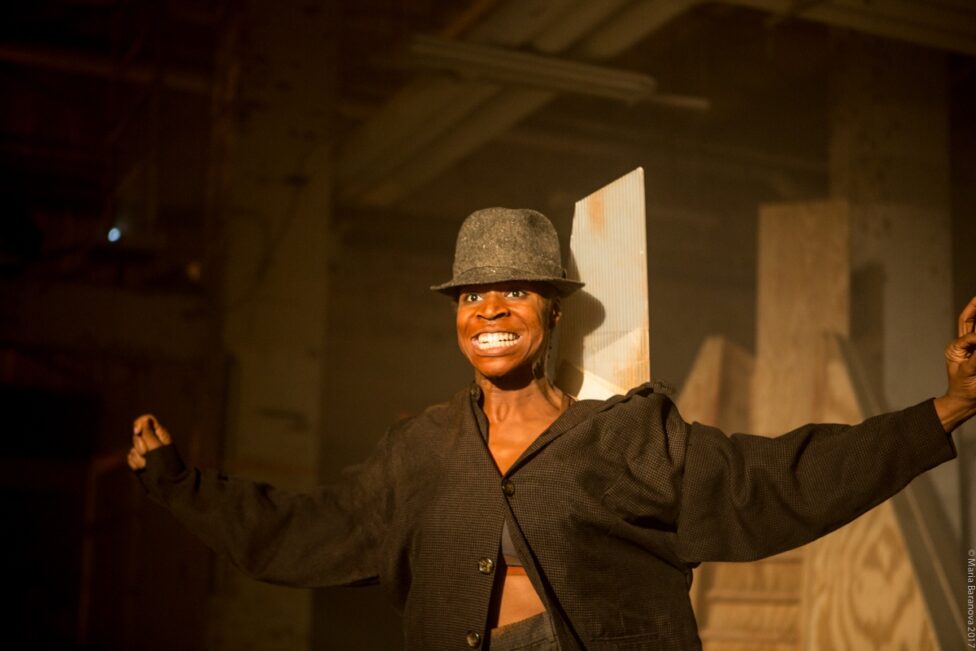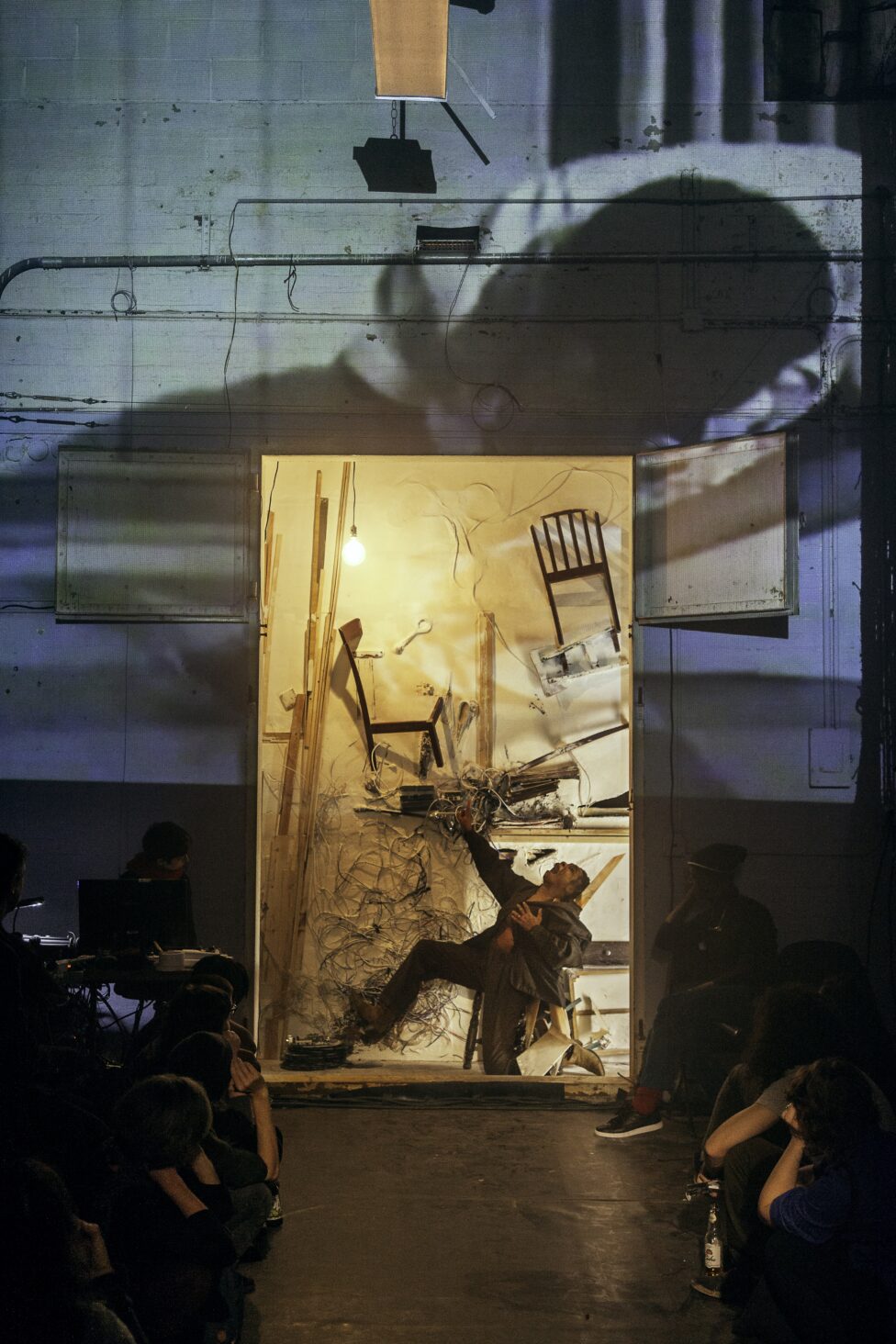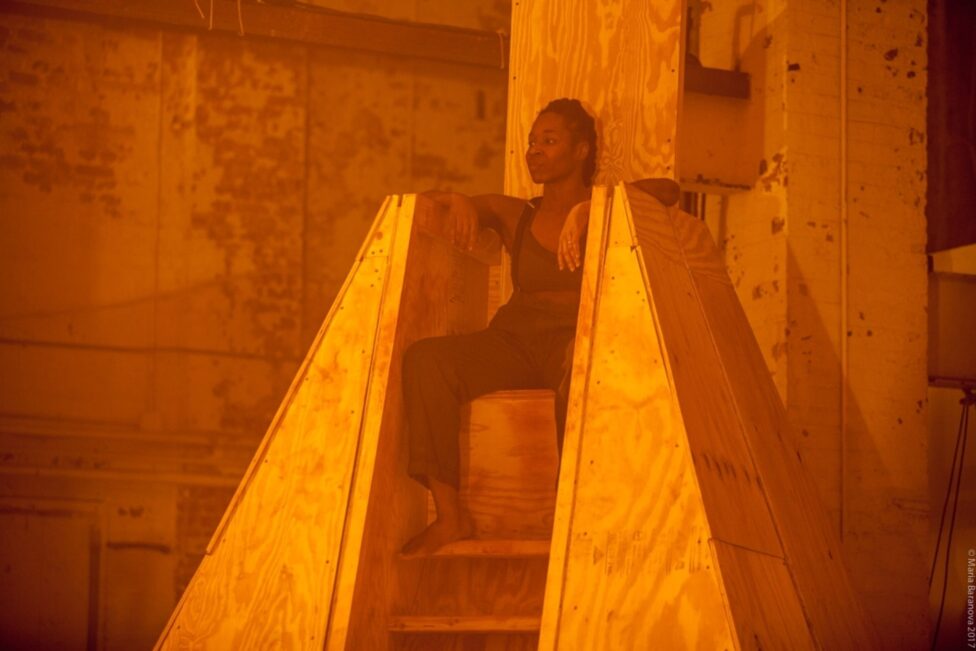Eva Yaa Asantewaa: What was your immediate reaction when you first read Alastair Macaulay’s New York Times review of Gillian Walsh’s Moon Fate Sin and Marjani Forté-Saunders’s Memoirs of a … Unicorn?
EYA: I wanted to open our discussion of the Macaulay review by taking a moment to step back from immediate analysis and critique of it and going directly to its effect on body and feelings, because that’s how it first hit me. And I use that word “hit” advisedly, because it felt like an assault (on Forté-Saunders) and an ambush (on me as reader), actually. I felt it. Maybe that’s because I am a Black woman, and my own Black body felt implicated in Forté-Saunders’s dance. Maybe because I know her, respect the rigor of her process and have empathy for her, imagining what it must feel like to get a strange review like this one. I immediately went to that very human place.
I think it’s important to start here, because I always like to remember that artists are human beings. They are not abstractions, and they are not commodities. I always start from a place of my own humanity, human receptiveness and empathy, which puts me on a more appropriate level with the artist. Works can be questioned, analyzed and, yes, even assessed, but from that level. At least, that’s how I see it.
Macaulay’s review confused me. I kept waiting for evidence of a defendable reason for him to cover two very different choreographers and works within the limited space of one relatively short review. So, what prompted him to make this choice, knowing that he’d only end up giving the shrift to both choreographers? I was not convinced by the opening comparison of lighting designs and, certainly, the unnecessary, unhelpful contrasting (“Ms. Forté-Saunders is in heeled shoes; Ms. Walsh and her four co-dancers are barefoot”). I was completely baffled.
Then he spent most of his space detailing what happened in Gillian’s Moon Fate Sin, which I have not seen. When he finally returned to Forté-Saunders’s work he merely slammed it with this: “But the main difference is that ‘Moon Fate Sin’ is a real piece, whereas ‘Memoirs’ is choppily incoherent.” The review ended a mere four sentences later following an admission from Macaulay that “‘Memoirs’ is an intensely personal piece with which I could make few connections.” Basically, he had used comparison with Walsh’s work as a way to dismiss Forté-Saunders’s work and avoid the labor (emotional and otherwise) of directly dealing with it, engaging it. What he saw as “incoherent,” I saw as complex and multifaceted, and intentionally so. He’s free, as a person–especially a white gay man from London–to not get it. But he’s not free, as a professional critic for New York’s preeminent venue for arts journalism, to throw his hands up and say, “I’m not even going to bother with this.” And that’s how I read it.
I no longer read Macaulay, as a rule, but he was reviewing new work by an artist I cared about. I’d seen, reviewed and cared about ‘Memoirs’. I was moved by it. I was astonished by the rigorous care and, especially, the visual imagination of the entire interdisciplinary production. I felt it was important to see how Macaulay was going to handle this work. While I thought it was no longer possible for me to be shocked by anything he might write, I was both shocked and shaken by this. Once I recovered, I was able to assess the structure of the review itself, and I found it to be something “choppily incoherent” with which I could make no connections.
Ali Rosa-Salas: I think Macaulay’s piece set into relief a lot of the critical concerns facing contemporary art journalism, which undoubtedly define the field at large: when power, influence, and knowledge production are highly concentrated among a select few, the circulation of ideas is in grave danger of losing dimensionality, rigor, and prismatic perspectives. In the case of dance criticism, the paucity of publishing opportunities coupled with the esteem/cultural capital endowed to particular publications, makes it so that readers are exposed to a particular perspective that goes on to define a context for a work art historically. All work is culturally specific, of course, and it is the duty of writers, like that of artists, to critically engage with these ideas, to research, to identify where they may need to deepen their understandings and to be committed to this process for the long haul. In the case of this particular review, both artists were deeply disserviced by the lack of critical engagement in how they are each operating not only within the trajectory of their particular practices, but also politically, aesthetically, and in contemporary performance discourses more broadly. Through arbitrary comparison, affirmation of aesthetic hierarchies–justified through racism and misogyny–took root, and by virtue its association to a highly regarded publication, are legitimized. By calling Forté-Saunders’ work “not a real piece,” as painfully uninformed that statement is, demonstrates how hyper subjectivity of writing is in and of itself knowledge production with consequences that are political, emotional, and material. I think it’s also necessary to reevaluate the practice of criticism itself. Who does it really serve? What values about U.S. American society does it uphold that are actually quite violent?
Nia Love: Macaulay’s review confused and appalled me. Although there have been very few reviews which have historically been in favor or rather have any cultural acuity of black culture, black folk, black work. I continue to be surprised at such concededly negligent behavior. Alastair Macaulay’s New York Times review of Gillian Walsh’s Moon Fate Sin and Marjani Forté-Saunders’s Memoirs of a … Unicorn, was another opportunity to publicly announce the monolithic wholes syndromes (reference-Joann Wheeler Kealiinohomoku) that are constantly and pervasively moving inside of documentation and archival conundrum of Blackness. I believe that Macaulay should be brought to task and sincerely held along with all patriarchal structures who are responsible for racist, sexist, and capitalist behavior and action. And yes I am not responding totally to the rhetoric and theoretical concepts that this review elicits only, but am leaning into what Eva Yaa Asantewaa so articulately spoke of
– [paraphrase]-
this wholeNess of mind, ‘body, guts, cell to cell’, oxygen…
that one has autonomy of ;
but because black lives are stilled imperiled and devalued from a calculus entrenched centuries ago’(Saidiya Hartman), I am responding to the continuous push beyond captivity- a reclaiming, reconstituting, and redefining for myself- for my culture. ‘I am post slavery’ (Saidiya Hartman) and that occupancy is no occupancy at all …it is nowhere and everywhere, it is definable and undefinable all inside and outside of body, space and geography! I must therefore, respond to this incredulous review that is steeped in a long line of dance writers- Kirsten, DeMille, Lincoln, Martin and many more who have all written, misdiagnosed, misdefined, ‘missed the boat’ in their so-called examination of black culture, Black stories, Black language, Black gesture, Black life.

Photo: Marjani Forté-Saunders in Memoirs of a… Unicorn. Photo by: Maria Baranova
EYA: I thought I might ask, then, what a work like ‘Memoirs’ is asking of people who witness it–critics, certainly, but actually all of us? How can we best witness and be in relationship with this work, specifically, and perhaps with any artist’s work?
ARS: Eva, that’s a really great question, and I think that’s what I was gesturing to in my last statement to the previous question. I think criticism is useful in so far as it is a reflection on one person’s subjective interpretation of a work. I think it is very dangerous for the vitality of one’s career to be hinged on the opinion of a select few. Like writers of historical texts, it is necessary for readers of art criticism to be acutely aware of how a writer is situating themselves/self-identifying socio-politically, economically, etc. With this kind of context, I as a reader will have a deepened understanding as to how art criticism interfaces with my own lived experience of performance. Clearly, I am far more interested in gaining more context about the subjectivity of critics, but am equally as invested in knowing more about the development process of artists. I wish for there to be more reflection on process in ways that do not necessarily always privilege writing, either. What about sound-based, video-based, movement-based reflection? What about reflection from youth? Production crew? Producers? How can we capture a more holistic picture and reflection of the trajectory of a work’s development? Marjani’s work is asking that viewers suspend notions of linearity, to lean into the sensation of opacity. Gillian’s work is operating similarly. These asks are poetic and affective, and completely defy the kind of binary logic that Macaulay engages with in his piece…it just does not work.
NL: To be present, to be comfortable in NOT knowing in the uncomfortability of it. As in any story, the purpose is to lean in and listen! To take the ride absorb the journey’s sensibilities w/o determining where you’ll end up immediately but rather trust that the story in the realm of time- from past to present and possible future. This act requires you the viewer, listener, to be indicted and hold yourself accountable to the new encounters for which you will face. To trust that the story’s truths will be lied in front of you but not without you doing some serious re-contextualizing and NO LONGER placing the you at the center of the story! Now for me, White folks place themselves at the center of every story. In their stories we are the back drop, the background, that which can be removed, that which is indispensable but yet available for appropriation at will. Black work/story, at any capacity requires anyone but in particular, white people to step back, displace themselves from the center of the story and reexamine their own place of privilege …and what that really looks like. Finally, I think that I fully partner with my teacher and mentor Madame Katherine Dunham when she, during an interview with John Martin, remarked…-“we are a complicated people”… apart of a very complexed conundrum of experiences in the wake of post slavery. So to best witness and be in relationship with this work, specifically, and perhaps with any artist’s work- requires one’s own implication and ability to take up action—the leaning in and [the] listening to, feeling the weight and silence of it all—this is how to begin!

Photo: Marjani Forté-Saunders in Memoirs of a… Unicorn. Photo by: Oscar Lewin
EYA: Dance artists have long complained that reviews in the Times–a publication hailed, worldwide, as “the newspaper of record”– rarely offers adequate documentation or assessment. Whenever the topic of dance criticism comes up, I hear artists say that they don’t bother reading Times reviews, that these reviews are no longer significant. And yet I see Times critics still invited to shows, find positive Times quotes or entire reviews included in press kits, and I imagine acceptable quotes are still going out to prospective funders, curators and presenters. I can attest that any positive Times review, or even mention, is still highly prized and is heartily celebrated in Facebook posts. So, I’d like to know which is it? Does a Times review make a difference in any way, or does it not? And what, if anything, might the dance community be willing to do to address the lack of adequate representation of its work to the general reader? Are we even concerned about reaching the general reader beyond dance specialists?
ARS: The “pull quote” is cultural capital. Even as we admonish its existence for all the reasons already mentioned, it still holds tremendous value given art criticism’s historical stake in defining what art “is” and “is not”. Ultimately, reviews are a kind of archival practice. I think writing about art is useful in so far as it does not serve an an “objective” arbiter of taste. Conversations that are distilled to defining what is and is not art are uninteresting at their best, and tyrannical at their worst. That kind of discourse only serves to perpetuate aesthetic hierarchies that seek to invalidate particular cultural practices, a system of dominance rooted in white supremacy. I think a Times review perhaps would not mean as much if as a field, we invested more resources and energy in time reflection and dialogue about work and process (that is NOT the post-show panel/Q&A). How can institutions, artists, and curators provide content and context for work that allows for publics to make connections across concepts, that makes room for us to question each other, rather than looking solely to a rarefied news source to “talk us through” what and how we should relate to work?. Mixtapes! Poetry! Snack time! Sociality is incredibly important in this process. I personally want to take myself to task as a curator in this work, host those kinds of opportunities for exchange.
NL: Yeah Ali, so agreed- sociality is and has always been important to the gravity of the way we hold and make space for one another in the circle.
EYA: One reason I started off asking for personal, visceral responses to the review (and, by extension, Marjani’s solo) had to do with my suspicion that we talk a good game about getting away from words and writing, but we’re still caught up in them, in concepts and rhetoric, when dance is something that works on us–cell to cell and soul to soul. This is, by the way, the way it works, can work, is going to work on people who don’t have dance-insider experience and could care less about theory but know what moves their hearts and guts and makes sense to their lived experience. This is where the hierarchy of expert of any kind breaks down, because we’re all experts on what connects when we witness dance. We’re all experts on our own bodies. We all have them. Thomas F. DeFrantz’s writing about mainstream (white) dance criticism and its limitations made me think about the reality that people have varying desires in witnessing dance and receive it in different ways. There are ways that dance insiders desire and receive dance, and ways that the casual dance-goer or the absolute novice might receive it, and I am curious and very interested in finding out more about that, but I rarely get a chance. I’ve always wanted more people to be exposed to the riches and the value of dance (as I experience them). Now I’m thinking how it would be exciting to hear how it makes them feel and think, people outside the bubble, outside the process, outside the jargon and buzzwords and rhetoric. Because, on some level, that’s where we might find out what dance is really capable of doing. If it’s capable of speaking to something that everyday people can respect and get excited about and maybe find useful. And what if it is? That’s a connection to get excited about, and I think that’s what Tommy was writing about in I am Black: (you have to be willing to not know). There are purposes for dance and responses to dance that some of these critics won’t know or share or respect, and that’s okay, because the work is not for them. What Marjani was doing was not for Alastair Macaulay. So his inability to connect with it is no surprise and doesn’t matter. But there are others who get even the fragmented way it was delivered–like fragmented memories pieced together. We have to listen to more of that, listen to one another, make space and venues for response and documentation of experiences that matter to us. Black lives matter. Marjani’s Black life and sensibility and work matter.






